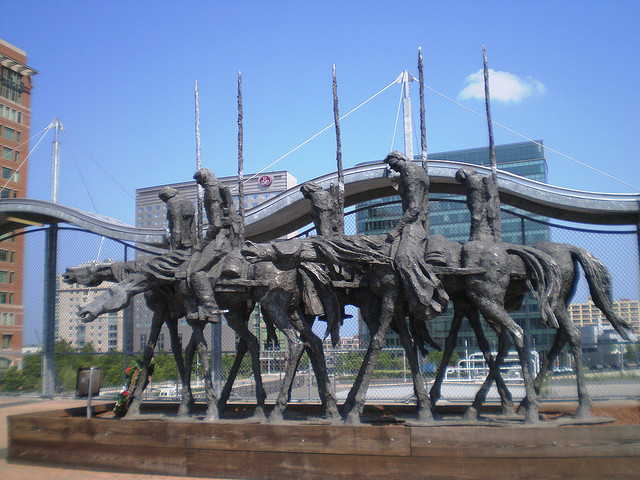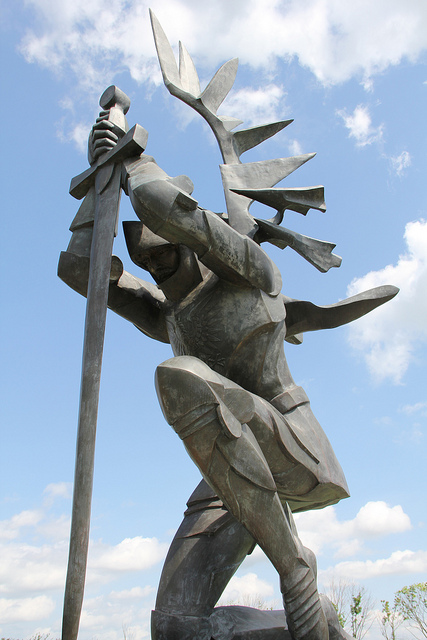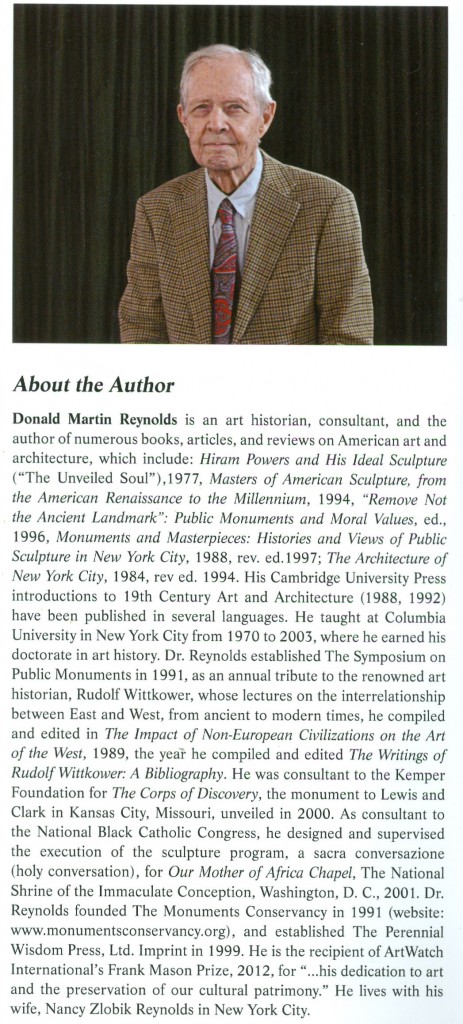BOOK REVIEW – “For Our Freedom and Yours”
Don Reynolds, The Art and Life of Andrew Pitynski, Perennial Wisdom Press, 2015, hardback, 536 pp, ISBN: 978-0-9814755-0-9
“A monument is an expressive symbol. A good one, looked at for even a few minutes, will remain in memory for years or even for an entire lifetime. Monuments are the milestones in a nation’s history.” – Andrew Pitynski
Peter Gibbon writes: On Boston Common once stood a gigantic sculpture of gaunt soldiers riding emaciated horses, spears pointed to the sky. The soldiers are Polish partisans resisting Joseph Stalin. A statue of Marie Curie, wearing her two Nobel Prize medals, stands in front of the Bayonne Public Library in New Jersey. The aluminum portrait bust of a proud, sad Frederick Chopin stares at a visitor in an artist’s studio in Poland.
These are just a handful of the 200 sculptures, commemorative medals, and portrait busts created by the Polish-American sculptor Andrew Pitynski that can be found in Donald Martin Reynolds’ splendid and beautifully illustrated new biography, “For Our Freedom and Yours,” The Art and Life of Andrew Pitynski, Portrait of an American Master.
Above: Partisans 1, Andrew Pitynski’s 1979 sculpture, as installed in 2007 at The Silver Line World Trade Center Station, Boston MA.
Reynolds brings to Pitynski a lifetime of studying sculpture, a belief in the importance of monuments, and a commitment to the figure and realism. “Monuments,” Reynolds writes, “when properly celebrated, can become forces within society for the perpetuation of traditions and human values.” To research Pitynski, Reynolds travelled to Poland, interviewed Pitynski’s family and friends, walked through cemeteries, toured battlefields, visited the sculptor’s classrooms and studios, and immersed himself in the craft of shaping the human figure out of metal and clay.
The result is a vivid, often tragic family history, a compelling personal biography, and an odyssey through Poland’s painful past, filled with war, imprisonment, tyranny, and torture. The book is also a celebration of Polish resistance and resilience. It is elegant, nearly 500 pages filled with historical photographs, hundreds of Pitynski’s etchings and charcoal drawings, portrait busts, reliefs, commemorative medals, and monumental sculptures. The endnotes testify to Reynolds’ diligent research, and the detailed explanations of Pitynski’s intricate art demonstrate Reynolds’ critical acumen.
Reynolds starts by telling the fascinating story of how a young man, marooned in Communist Poland, became an artist. Pitynski comes from a distinguished Polish family. Embedded in his DNA are horses, rafting, fishing, Catholicism, and a fierce resistance to Poland’s many oppressors, particularly the Communists who shot Pitynski’s grandmother and captured, imprisoned, and tortured his father. One of the most powerful images in the book is the bronze portrait bust of his father, his face clearly battered by beatings, his gaze stubborn and defiant.
Under Communist rule, Pitynski struggled to get an education and find his artistic voice. An elementary school teacher recognized his talent and a high school principal encouraged his defiance. Though discouraged by Communist officials, Pitynski persisted, remembering, “I knew my day would come when I could speak out through my art.” Eventually, he was admitted to the prestigious Cracow Academy of Fine Arts, which in the words of Reynolds was “…a formal and tangible affirmation of the vitality and continuity of Polish culture…”
At the Cracow Academy, Pitynski learned the craft of bronze casting, studied Polish folk art, took a few lessons from “socialist realism,” and tried to ignore the Communist message he detested. By chance, in 1974 he obtained a visa to America. He remembers: “As I stepped on to that American plane on October 3, 1974, I looked back and smiled to myself. I knew that I would never return to that Poland, to those Communist bastards. And for the first time in my life, I felt really free.”
Pitynski worked in demolition, made contacts, and taught art and sculpture at schools in Princeton, New Jersey, and Greenpoint, Brooklyn. He received commissions and came to the attention of Seward Johnson, America’s foremost artisan/entrepreneur. Johnson founded the International Sculpture Center of Hamilton, New Jersey, and is known for his life-sized sculptures of ordinary people engaged in day-to-day activities. These sculptures can be found in cities all over America. Johnson encouraged Pitnyski to create his monumental partisan statue on the Boston Common. At the end of the Cold War, as Poland moved itself towards independence and self-determination, Johnson commissioned a more heroic version for his sculpture gardens in New Jersey
Pitynski has chosen to represent his nation’s calamity: Chopin’s exile, the 1940 Katyn Massacre of Polish officers and intellectuals by Russia, the deportation of Polish men and women to Siberia, the German and Russian torture chambers, the bitter civil war and underground resistance that continued after 1945.
Simultaneously, Pitynski portrays with painstaking research and historical accuracy his nation’s commitment to resistance and freedom. He also portrays its heroes: Jan Paderewski, the famous pianist who persuaded Woodrow Wilson in 1920 to include an independent Poland in his Fourteen Points; Jan Karski, the Polish resistance fighter, who first alerted the world to the reality of the Nazi death camps; and Pope John Paul who, along with the partisans, helped end Communist rule.
Above: Andrew Pitynski at work on the plaster for Avenger in 1986; below, the bronze and granite Avenger monument at Doylestown, PA, 1988.
Why does Pitnyski’s work matter to Americans? There are Polish Americans living in Greenpoint, Brooklyn; in Doylestown, Pennsylvania; on the Lower East Side of Manhattan; in Chicago’s South End; and spread out in Milwaukee. They and their ancestors fled deprivation and tyranny. They remember Poland’s catastrophic 20th century, offer commissions to an artist who remembers his homeland, and attend the dedication of his monuments.
Pitynski also celebrates Poles who fought for America’s freedom. In medals he celebrates Kazimierz Pulaski, the father of American Cavalry who, as Reynolds notes, wrote to George Washington: “I came here, where freedom is being defended, to serve it, and to live or die for it.” In St. Petersburg, Florida, a bronze, eight-foot high stature of Thaddeus Kosciuszko stands on top of a granite base. An engineer, Kosciuszko designed the fortifications along the Hudson River at West Point. He is portrayed in military uniform, his right arm thrusting forward his famous will in which he leaves his entire estate to the Negroes of America so that they could be free, educated and assimilated. Of Kosciuszko Jefferson said: “He is as pure a son of liberty, as I have ever known and of that liberty which is to go to all, and not to the few or rich alone.” Pitynski reminds us he is engaged in an eternal fight “for our freedom and yours.”
In a cynical age, Pitynski is patriotic, idealistic, and realistic. Where moral relativism is common, Pitynski is didactic and certain. In an art world fond of abstract sculpture, Pitynski is devoted to classical beauty, representation, romanticism, and reality—all making his work arresting and moving.
Donald Martin Reynolds has spent his career describing and appreciating monuments. They are, he insists, a reflection of a society’s values, a preservation of the past, an escape from death, and an inspiration to the living. In Pitynski’s work, he sees “the deeper truths of nobility, patriotism, and loyalty.” In this, Reynolds is describing his own credo.
Peter Gibbon is a Senior Research Scholar at the Boston University School of Education and the author of A Call to Heroism: Renewing America’s Vision of Greatness (Atlantic Monthly Press, 2002). He has directed four Teaching American History programs and is currently the director of an NEH Seminar, “Philosophers of Education: Major Thinkers from the Enlightenment to the Present.”
Don Reynolds gave the 2016 James Beck Memorial Lecture on the art and life of Andrew Pitynski.
25 June 2017.









Leave a Reply